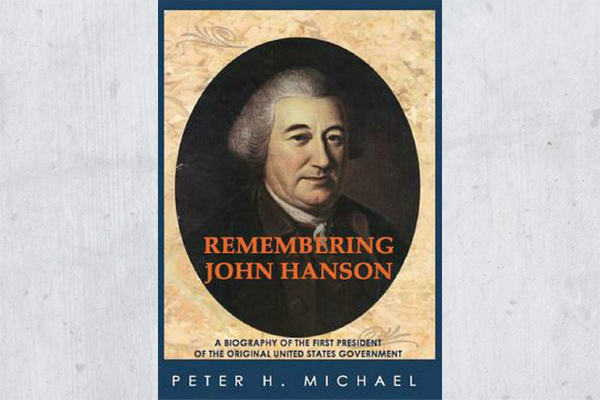Every American knows that George Washington was the first president of the United States, right?
Actually, no.
A man named John Hanson was chosen to be the first chief executive of the infant U.S. eight years before Washington, and Hanson was also instrumental in the formation of our country. Nevertheless, he has been largely forgotten since the mid-19th century.
The details are related in “Remembering John Hanson: A Biography of the First President of the Original United States Government,” by Peter Hanson Michael (Underground Railroad Free Press).
Hanson was “an indispensable Founder in forging United States independence; raising money, materiel and militias to prosecute the Revolutionary War; ... brokering the Articles of Confederation,” which created our first national government; and serving as the first President of the infant United States.
The Hansons were a prominent Maryland family. John Hanson and his wife, Jane, were neighbors and friends of George Washington and his wife, Martha. Both families were plantation owners who, like several more of this nation's Founders, were slave owners.
Hanson was just one of many Marylanders of all social stations who embraced their British heritage but longed for a stronger voice in the affairs of their province, initially on taxation issues “but later on all political matters,” Michael writes. Hanson grew increasingly resentful of “British superciliousness” toward the American colonies.
For example, Maryland was deemed by the British government to be the personal property of a Proprietor who lived in Britain and could govern the colony any way he wanted to. Also, only about one in 20 adult Maryland residents was eligible to vote.
By 1774 Hanson had become an openly proclaimed rebel, Michael writes.
As the colonists girded for war, Hanson issued a call for volunteers in 1775 and enlisted two companies of soldiers totaling more than 200 men, the author says. By the end of the war Maryland had provided nearly 1,400 troops to the Continental Army, 18% of the state’s adult male population at that time.
When the debate in Congress for independence came to a head in June 1776, Maryland was balking. Hanson persuaded the Maryland delegates to rescind instructions they had received in 1775 to oppose independence and instead support the break with Britain.
Although Americans celebrate July 4, 1776, as Independence Day, consummation of nationhood was not attained until five years later. During the interim, the 13 original colonies were sovereign states in nearly every respect, “united in name only...” There was no central, national government.
Funding for the Revolutionary War was “voluntary, sporadic and sparse,” Michael relates. Consequently, by 1776 Hanson was helping fund the war from his own pocket. He financed military payrolls, paid for the manufacture and purchase of war materiel such as guns and blankets, and shouldered other expenses such as food and drink required to sustain the Continental Army.
The author says it cannot be calculated with certainty how much Hanson advanced to the U.S. and Maryland governments to prosecute the Revolutionary War, but it’s estimated he spent perhaps as much as $15 million (in 2012 dollars) to support the war and the nation – and most of it was never reimbursed.
On March 1, 1781, delegates to the Second Continental Congress signed the Articles of Confederation which created the awkwardly named “United States in Congress Assembled.”
Eight months later, on Nov. 5, 1781 – just a couple of weeks after General Lord Cornwallis was defeated at Yorktown and surrendered his British troops, effectively ending the war – delegates to the new national government gathered and unanimously elected Maryland’s John Hanson to be our first President.
Michael, a Hanson family descendant, claims that George Washington himself referred to John Hanson as the first President of the United States, and so did Thomas Jefferson, James Madison, and President Harry Truman. Hanson was “recognized at home and abroad as the President of the United States of America.”
Hanson served only a one-year term, but during that period he presided over several housekeeping chores that were essential to establishing a national government. He ordered the first census, authorized the nation’s first central bank, established the nation’s first uniform system of coinage, created a national army and navy, and authorized creation of the Great Seal of the United States, which is still in use today. He also decreed Thanksgiving Day to be observed on the last Thursday in November, and established the Fourth of July as a permanent annual national observance.
Another enduring national custom established during the Hanson administration was the provision of an executive mansion (initially in Philadelphia but now the White House in Washington, D.C.) for the nation’s chief executive officer.
Hanson “sacrificed his health, working long days late into his 60’s in an era when life expectancy was about 30,” Michael writes. Hanson finally retired at age 67 and died a year later, in 1783. He is the only person from Maryland who ever became President of the United States.
Although John Hanson was “one of America’s greatest statesmen,” Michael declares, he subsequently faded from sight and became “the most forgotten major figure in American history.” A prime cause of “the dimmed national memory” of John Hanson is that many of his personal papers have vanished, and he served just one year as this nation’s chief executive officer. Hanson’s gravesite was forgotten over time, too, and has been lost; his final resting place is a mystery.


